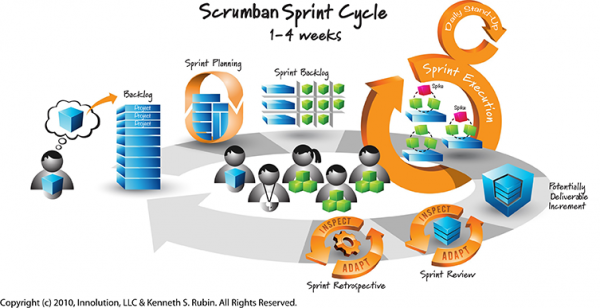Agile Marketing for the AVL Industry
 Reaching the house of worship market with your marketing message requires a new set of marketing skills and tools that have been widely adopted by software technology companies, but relatively few that I’m aware of in the Audio, Video, Lighting (AVL) manufacturing and distribution firms. To take full advantage of the combination of social, search, print, trade show, publications and website marketing channels, the way your marketing team approaches creating content relative to various personas — including church buyers and influencers — has changed rapidly over the past few years.
Reaching the house of worship market with your marketing message requires a new set of marketing skills and tools that have been widely adopted by software technology companies, but relatively few that I’m aware of in the Audio, Video, Lighting (AVL) manufacturing and distribution firms. To take full advantage of the combination of social, search, print, trade show, publications and website marketing channels, the way your marketing team approaches creating content relative to various personas — including church buyers and influencers — has changed rapidly over the past few years.
For those of you building hardware and software, the methodology of Agile (such as Scrum or Kanban) is likely something either in place already or something you’ve considered (and should adopt). The principles are simple: Agile is a time boxed, iterative approach to delivery that builds software/hardware/content incrementally from the start of the project, instead of trying to deliver it all at once near the end. It works by breaking projects down into little bits of user functionality called user stories, prioritizing them and then continuously delivering them in short delivery cycles called Sprints. The benefit of Agile is not only faster development, but better results through continuous improvement.
Agile Marketing applies this same approach to content creation and delivery, yielding better marketing pieces targeted at more specific personas to achieve a higher conversion rate of Marketing Qualified Leads for your sales teams.
As a marketer and communicator, I’ve found myself trying to balance the organizational needs of planning against the realities of responding to change in a timely fashion, only to realize that I seemingly could not find a way to do both well. Until Agile Marketing came along.
Over the years, I’ve worked with and around software developers and first appreciated, and then come to study and use their secret, to delivering code quickly and adapting just as fast to new features and bug fixes. They’ve made the development shift to Agile and I saw the huge benefits of faster shippable products with fewer defects and greater adoption and wondered how I could apply their success to marketing and communications.
Project Planning and The New Agile
To help quickly get started, here’s a very brief recap of they way things used to be versus how they are now in project planning:
- Software used to be fully considered, mapped out, documented and planned for a final finished release. This method, called Waterfall, was to do all of the pre-planning and documentation for everything the software would need to do in one, very large and complex project plan, complete with Gantt charts to estimate work over months and even years.
- Software-as-a-Service (software you use online, in an app, or in a browser, most frequently) changed the need for more iterative software changes that responded to demands and needs of users as quickly as possible – sometimes days or weeks.
- Agile is a belief that a collaborative team working in short durations together can deliver more often and change more rapidly to meet market demands.
- Scrum is a methodology for applying Agile that plans all work in chunks (2 to 4 weeks is common, and is called a ‘Sprint’) and follows ‘ceremonies’ that organize the work during the planned Sprint.
- Kanban is an Agile approach that visualizes work (a board with notes or cards), limits the work in progress (no multitasking allowed!) and focuses on workflow.
- Both Scrum and Kanban provide continuous improvement through measurement, discussion and learning.
When you’re about to roll out a new or updated solution at a major trade show, It’s hard to juggle the pre-planned work against the pressures of unplanned work due to necessary changes. Agile helps your marketing team prioritize the deliverables and the distribution channels so that major product announcements targeting your specific audience have the greatest chance of being seen, heard, and acted upon.
Marketing is always in a responsive mode given the nature of the work, so planning every detail out with rigid inflexibility is lunacy. Prioritizing the marketing effort is key to creating better conversion rates for AVL sales teams.
While it’s ideal for marketing and communication teams to plan some level of their work for coordination of deliverables around key dates using Editorial Calendars, being able to pivot as new, urgent unplanned work or changes due to external pressures happen, such as social media timeliness, a change in publication dates, a shift in deliverables, etc., your marketing will be timely and relevant to help stand out from the noise of your competitors.
The New Normal of Marketing & Comms
Allow me to illustrate how I lead my team in using Scrumban.
 Sample concept of a Kanban board used in Scrumban. Note: this is a simplified mock-up for illustrative purposes only.
Sample concept of a Kanban board used in Scrumban. Note: this is a simplified mock-up for illustrative purposes only.
We plan our work into two-week Sprints (a term that describes a focused team effort for a limited duration) and spend several hours on the first Monday of a Sprint in a Sprint Planning session. To organize and prioritize our potential work for these two weeks, we first look at our Editorial Calendar to see what’s due next, and when we have to be ready to publish. Once all due dates and work related to these timelines is organized into Epics (over-arching projects) and Stories (tasks and dependencies) with fully detailed User Stories (a short Scope of Work), we then look at what else needs to be done that doesn’t necessarily have a hard deadline. To rank these, we discuss which of the Epics will realize the most value for the company. Finally, if there’s a dead tie between due dates and value, the tie-breaker is WSJF (Weighted Shortest Job First). This simply means that if all other things are equal, do the one that can be done fastest, first.
 Agile Marketing – ‘Scrumban’ Framework. Thanks to Innolution, LLC & Kenneth Rubin for the original Scrum diagram.
Agile Marketing – ‘Scrumban’ Framework. Thanks to Innolution, LLC & Kenneth Rubin for the original Scrum diagram.
So, to summarize: Agile Marketing keeps the accountability and transparency high while also adapting to the realities of change for marketing. The key is to find what works for your culture and marketing team’s workflow.
Is your marketing team consistently delivering the right content to the right channels to get the best conversion rates for your sales teams? Or are they still using the old method of putting out fires to respond to urgent requests and not bringing the best value to your firm’s marketing efforts? Share your views and opinions in the comments below.





